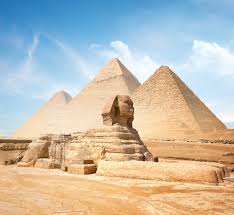Stamp: Sphinx in front of Cheops pyramid - New value overprinted (Egypt 1884)
Sphinx in front of Cheops pyramid - New value overprinted (Egypt 1884)
01 February (Egypt ) within release Sphinx in front of Cheops pyramid goes into circulation Stamp Sphinx in front of Cheops pyramid - New value overprinted face value 20 Egyptian para
| Stamp Sphinx in front of Cheops pyramid - New value overprinted in catalogues | |
|---|---|
| Michel: | Mi:EG-A 31 |
| Yvert et Tellier: | Yt:EG 31 |
Stamp is square format.
Stamp Sphinx in front of Cheops pyramid - New value overprinted it reflects the thematic directions:
Sculpture is the branch of the visual arts that operates in three dimensions. Sculpture is the three-dimensional art work which is physically presented in the dimensions of height, width and depth. It is one of the plastic arts. Durable sculptural processes originally used carving (the removal of material) and modelling (the addition of material, as clay), in stone, metal, ceramics, wood and other materials but, since Modernism, there has been almost complete freedom of materials and process. A wide variety of materials may be worked by removal such as carving, assembled by welding or modelling, or moulded or cast.
A monument is a type of structure that was explicitly created to commemorate a person or event, or which has become relevant to a social group as a part of their remembrance of historic times or cultural heritage, due to its artistic, historical, political, technical or architectural importance. Examples of monuments include statues, (war) memorials, historical buildings, archaeological sites, and cultural assets. If there is a public interest in its preservation, a monument can for example be listed as a UNESCO World Heritage Site. The Palgrave Encyclopedia of Cultural Heritage and Conflict gives the next definition of monument:
A pyramid (from Ancient Greek πυραμίς (puramís) 'pyramid') is a structure whose visible surfaces are triangular and converge to a point at the top, making the shape roughly a pyramid in the geometric sense. The base of a pyramid can be of any polygon shape, such as trilateral or quadrilateral.
A number is a mathematical object used to count, measure, and label. The most basic examples are the natural numbers 1, 2, 3, 4, and so forth. Numbers can be represented in language with number words. More universally, individual numbers can be represented by symbols, called numerals; for example, "5" is a numeral that represents the number five. As only a relatively small number of symbols can be memorized, basic numerals are commonly organized in a numeral system, which is an organized way to represent any number. The most common numeral system is the Hindu–Arabic numeral system, which allows for the representation of any non-negative integer using a combination of ten fundamental numeric symbols, called digits. In addition to their use in counting and measuring, numerals are often used for labels (as with telephone numbers), for ordering (as with serial numbers), and for codes (as with ISBNs). In common usage, a numeral is not clearly distinguished from the number that it represents.



